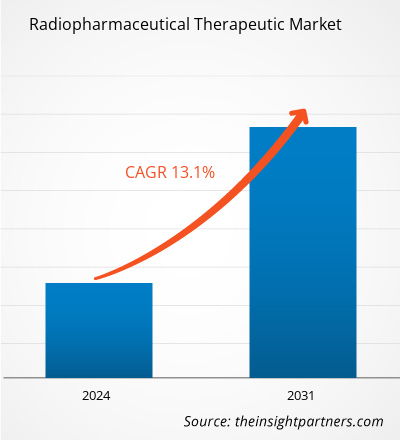放射性药物治疗市场规模预计将从 2023 年的 27.1 亿美元增至 2031 年的 73.0 亿美元。预计 2023-2031 年市场复合年增长率将达到 13.1%。在核医学成像设备中引入人工智能算法来优化治疗计划很可能仍是放射性药物治疗市场的一个主要趋势。
放射性药物治疗市场分析
医学成像行业的快速扩张、对个性化医疗的日益增长的偏好、放射性药物治疗的突破、改进靶向策略的技术发展以及政府投资的增加是推动放射性药物治疗市场收入的主要因素。
放射性药物治疗市场概况
用于治疗癌症和其他疾病的含有放射性同位素的药物被称为放射性药物疗法。为了尽量减少对健康组织的损害,这些放射性药物被制成专门针对并直接向疾病部位发射高剂量辐射。
由于核医学技术的发展、对更好治疗方案的需求不断增长以及慢性病患病率的上升,放射性药物治疗市场前景光明。此外,个性化医疗和靶向治疗的接受度不断提高预计将支持市场扩张。
定制此报告以满足您的需求
您可以免费定制任何报告,包括本报告的部分内容、国家级分析、Excel 数据包,以及为初创企业和大学提供优惠和折扣
- 获取此报告的关键市场趋势。这个免费样品将包括数据分析,从市场趋势到估计和预测。
放射性药物治疗市场驱动因素和机遇
靶向治疗日益普及,推动市场增长
靶向治疗是用于局部和全身癌症治疗的最新和不断发展的技术。临床前研究和临床试验表明,发射α粒子的放射性核素会杀死目标癌细胞,而不会损害附近的健康细胞。225Ac 和 227Th 是附着在单克隆抗体上的发射α粒子的放射性同位素,可通过局部释放高剂量的辐射选择性地识别和杀死癌细胞。α辐射适用于杀死血管和淋巴系统中孤立的癌细胞,并通过扰乱肿瘤毛细血管网络来靶向和杀死肿瘤毛细血管内皮细胞来使肿瘤消退。镭-223 二氯化物α疗法是唯一获批的内部发射α粒子的放射性同位素癌症治疗概念。靶向放射性核素治疗是靶向治疗类别中的一种。全身给药的靶向放射治疗结合了癌细胞靶向的特异性和已知的电离辐射抗肿瘤作用,有可能同时根除原发性肿瘤部位和已扩散到全身的癌症,包括诊断成像无法检测到的恶性细胞群。有两种商业上批准的放射免疫治疗药物,钇-90 伊布替莫单抗(Zevalin;Biogen-Idec Pharmaceuticals,2002 年获批)和碘-131 托西莫单抗(BEXXAR,葛兰素史克,2003 年获批),这两种药物都用于治疗惰性 B 细胞淋巴瘤和相关癌症。因此,在癌症治疗中优先使用靶向疗法推动了放射性药物治疗市场的增长。
企业间战略联盟有利于市场增长
战略联盟和协议有助于发现癌症研究领域的突破性解决方案,同时与拥有相同愿景的企业建立更深层次的关系。战略联盟可以潜在地增加公司的收入和盈利能力,并通过增加产品组合帮助公司在放射治疗领域取得进步。以下是一些正在进行战略联盟的公司:
2021 年 6 月,Nimble Therapeutics 与 RayzeBio 达成战略研究合作,旨在发现和开发用于治疗癌症的新型肽类放射性药物。RayzeBio 拥有开发和销售合作中发现的肽类药物的独家权利,并有权选择进一步扩大合作范围,以涵盖其他目标。
2024 年 1 月,Lantheus Holdings, Inc. 与 Perspective Therapeutics, Inc. 达成多项战略协议,后者是一家开创全身癌症先进治疗解决方案的放射性制药公司。根据协议,Lantheus 有权独家授权 Perspective 的 Pb212-VMT-⍺-NET,这是一种用于治疗神经内分泌肿瘤的临床阶段 alpha 疗法,并且有权使用 Perspective 的创新领先平台技术共同开发某些针对前列腺癌的早期治疗候选药物。这些战略交易将扩大 Lantheus 的产品线,并为神经内分泌肿瘤和前列腺癌的重大进展开辟道路。
2024 年 3 月,Ratio Therapeutics Inc. 扩大了与 PharmaLogic 的制造协议,PharmaLogic 是一家专注于放射性药物生产和分销的世界级合同开发和制造组织。此次合作大大加快了 Ratio 下一代放射疗法的开发和商业化,标志着 Ratio 推进成纤维细胞活化蛋白-α (FAP) 靶向放射治疗候选药物的关键组成部分。
放射性药物治疗市场报告细分分析
有助于得出放射性药物治疗市场分析的关键部分是产品类型、治疗类型、应用和最终用户。
- 根据产品类型,放射性药物治疗市场分为锝-99m、铊-201、镓-68、碘-131、铜-64 等。锝-99m 部分在 2023 年占据最大市场份额,预计在预测期内将实现最高复合年增长率。
- 根据治疗类型,市场分为 α 发射体、β 发射体和近距离放射治疗同位素。β 发射体部分在 2023 年占据了最大的市场份额,预计在预测期内将实现最高的复合年增长率。
- 就应用而言,市场分为肿瘤学、神经病学、心脏病学等。肿瘤学领域在 2023 年占据最大的市场份额,预计在预测期内将实现最高的复合年增长率。
- 根据最终用户,放射性药物治疗市场分为医院、肿瘤诊所和其他。医院部门在 2023 年占据最大的市场份额,预计在预测期内将实现最高的复合年增长率。
放射性药物治疗市场份额按地区分析
放射性药物治疗市场报告的地理范围主要分为五个地区:北美、亚太、欧洲、中东和非洲、南美和中美。
北美在放射性药物治疗市场占据主导地位。该地区致力于技术创新并采用尖端成像模式,巩固了其在放射性药物治疗领域的卓越地位。用于治疗的靶向放射性药物将放射性核素直接输送到身体任何部位的肿瘤,因此,靶向放射性药物引发了人们对治疗卵巢癌的临床开发的兴趣。美国国家癌症研究所利用放射性药物在卵巢癌临床应用方面的先前经验,进一步开发了结合放射性药物,未来可能会考虑用于化疗难治性卵巢癌患者的治疗。因此,上述因素促成了北美在放射性药物治疗市场的主导地位。
放射性药物治疗市场新闻和最新发展
放射性药物治疗市场通过收集一级和二级研究后的定性和定量数据进行评估,其中包括重要的公司出版物、协会数据和数据库。以下是放射性药物治疗市场的发展和战略列表:
- 拜耳与 Bicycle Therapeutics 达成战略合作,旨在发现、开发、制造和商业化肿瘤领域新型靶向放射性核素疗法。(来源:拜耳股份公司,新闻稿,2023 年)
- 诺华获得欧盟委员会批准,用于靶向放射性配体疗法 Pluvicto(INN:镥(177Lu)vipivotide tetraxetan)。Pluvicto 获批与雄激素剥夺疗法联合使用,无论是否联合雄激素受体通路抑制,用于治疗前列腺特异性膜抗原 (PSMA) 阳性转移性去势抵抗性前列腺癌 (mCRPC) 成年患者。(来源:诺华,新闻稿,2022 年)
放射性药物治疗市场区域洞察
Insight Partners 的分析师已详尽解释了预测期内影响放射性药物治疗市场的区域趋势和因素。本节还讨论了北美洲、欧洲、亚太地区、中东和非洲以及南美洲和中美洲的放射性药物治疗市场细分和地理位置。

- 获取放射性药物治疗市场的区域特定数据
放射性药物治疗市场报告范围
| 报告属性 | 细节 |
|---|---|
| 2023 年的市场规模 | 27.1亿美元 |
| 2031 年市场规模 | 73亿美元 |
| 全球复合年增长率(2023 - 2031) | 13.1% |
| 史料 | 2021-2022 |
| 预测期 | 2024-2031 |
| 涵盖的领域 | 按产品类型
|
| 覆盖地区和国家 | 北美
|
| 市场领导者和主要公司简介 |
|
放射性药物治疗市场参与者密度:了解其对业务动态的影响
放射性药物治疗市场正在快速增长,这得益于最终用户需求的不断增长,而这些需求又源于消费者偏好的不断变化、技术进步以及对产品优势的认识不断提高等因素。随着需求的增加,企业正在扩大其产品范围,进行创新以满足消费者的需求,并利用新兴趋势,从而进一步推动市场增长。
市场参与者密度是指在特定市场或行业内运营的企业或公司的分布情况。它表明在给定市场空间中,相对于其规模或总市场价值,有多少竞争对手(市场参与者)存在。
在放射性药物治疗市场运营的主要公司有:
- 康德乐
- 拜耳
- 诺华
- Jubilant DraxImage Inc.
- 锔
- 烟台东诚医药集团
免责声明:上面列出的公司没有按照任何特定顺序排列。

- 了解放射性药物治疗市场的主要参与者概况
放射性药物治疗市场报告覆盖范围和交付成果
“放射性药物治疗市场规模和预测(2023-2031)”报告对以下领域进行了详细的市场分析:
- 范围内涵盖的所有主要细分市场的全球、区域和国家层面的市场规模和预测
- 市场动态,如驱动因素、限制因素和关键机遇
- 未来主要趋势
- 详细的 PEST 和 SWOT 分析
- 全球和区域市场分析涵盖关键市场趋势、主要参与者、法规和最新市场发展
- 行业格局和竞争分析,涵盖市场集中度、热点图分析、知名参与者和最新发展
- 详细的公司简介
- 历史分析(2 年)、基准年、预测(7 年)及复合年增长率
- PEST和SWOT分析
- 市场规模、价值/数量 - 全球、区域、国家
- 行业和竞争格局
- Excel 数据集
近期报告
相关报告
客户评价
购买理由
- 明智的决策
- 了解市场动态
- 竞争分析
- 客户洞察
- 市场预测
- 风险规避
- 战略规划
- 投资论证
- 识别新兴市场
- 优化营销策略
- 提升运营效率
- 顺应监管趋势





















 获取免费样品 - 放射性药物治疗市场
获取免费样品 - 放射性药物治疗市场